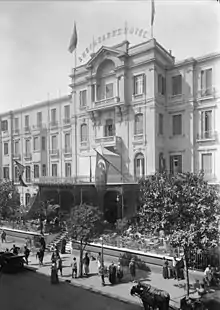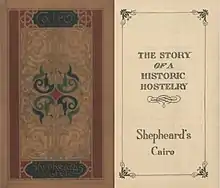Shepheard's Hotel
Shepheard's Hotel was the leading hotel in Cairo and one of the most celebrated hotels in the world from the middle of the 19th century until its destruction in 1952 during the Cairo Fire. Five years after the original hotel was destroyed, a new one was built nearby and was named the Shepheard Hotel.

History

The hotel was originally established in 1841 by Samuel Shepheard under the name "Hotel des Anglais" (English Hotel),[1][2] and was later renamed "Shepheard's Hotel".[3] Shepheard, an Englishman who was once described as "an undistinguished apprentice pastry chef",[4] came from Preston Capes, Northamptonshire. He co-owned the hotel with Mr. Hill, Mohammed Ali Pasha's head coachman, and proved to be a successful entrepreneur and businessman. On one occasion, when soldiers staying at the hotel were suddenly moved to Crimea, leaving unpaid bills, Shepheard travelled personally to Sevastopol in order to collect payment.[1]
In 1845, Hill relinquished his interest in the hotel, and Shepheard became the sole owner. Shepheard sold the hotel in 1861 for £10,000[5] and retired to Eathorpe Hall, Eathorpe, Warwickshire, England. Richard Burton, a close friend of Shepheard, left a detailed description of his generous character and successful career, describing him as "a remarkable man in many points, and in all things the model John Bull".[5][6] Shepheard's Hotel was famed for its grandeur, for its guests, and as a base for the military. It was renowned for its opulence, with stained glass, Persian carpets, gardens, terraces, and great granite pillars resembling those of the Ancient Egyptian temples. Its American Bar was frequented not only by Americans but also by French and British officers. There were nightly dances at which men appeared in military uniform and women in evening gowns.
The bar was also known as the "long bar" because it was always so crowded that it required considerable waiting to get a drink.[7] In 1941-42, when there were very real fears that the Wehrmacht's Afrika Korps under Erwin Rommel might take Cairo, a popular joke amongst the British and Australian soldiers waiting for service at the "long bar" was: "Wait until he [Rommel] gets to Shepheard's; that'll hold him up".[8] The Suffering Bastard cocktail was created at the bar.[9] Bartender Joe Scialom was looking to make a hangover drink for allied troops and according to story made one as a "cure" for the suffering soldiers who complained about the poor quality of liquor in the area.[10] During the fighting, Nazi General Rommel allegedly said "I'll be drinking champagne in the master suite at Shepheard's soon".[11]
The "long bar" was popular with the cabinet of the Greek government-in-exile, and Harold Macmillan wrote in his diary on 21 August 1944 that the Greek government-in-exile should move to Italy to escape the "poisonous atmosphere of intrigue which reigns in Cairo. All previous Greek governments-in-exile have been broken in the bar of Shepheard's".[12]
Tourist shops faced the hotel from across the street, and there was a storeroom where officers could leave their excess luggage. Reviews of the hotel's cuisine varied over time. At an early stage, its food was said to leave "much to be desired"[4][13] but, by the middle of the 20th century, others were describing the food as "as good as anything at Paris' Ritz, or Berlin's Adlon, or Rome's Grand".[14]
Among its famous guests were Aga Khan, the Maharajah of Jodhpur and Winston Churchill.[15]
On 26 January 1952 the hotel was destroyed during the Cairo Fire, a period of anti-British riots and dramatic civil unrest that led to the Egyptian Revolution of 1952.[16][17]
In popular culture
The hotel has had many notable fictional guests. It was portrayed in the 1934 British film The Camels are Coming.[18] The hotel is the setting for a number of scenes in the 1996 film The English Patient but actual filming of the scenes happened at The Grand Hotel des Bains in Venice Lido, Italy.[19] The hotel is used as a base of operations in The Race Colonization series by Harry Turtledove,[20] as a location in Agatha Christie's Crooked House,[21] and is mentioned in Anthony Trollope's short-story, An Unprotected Female at the Pyramids (1861).[22] It also features regularly in Elizabeth Peters' Amelia Peabody novels.[23][24][25]
Modern Shepheard Hotel
A "Shepheard Hotel" was erected in 1957 by Egyptian Hotels Ltd. in Garden City, Cairo, about 1⁄2 mile (0.80 km) from the site of the original hotel. The new hotel, and the land on which it sits, is owned by E.G.O.T.H. (The Egyptian General Company for Tourism & Hotels). The hotel was managed by Helnan International Hotels and known as the Helnan Shepheard Hotel[4] until September 29, 2009, when the Rocco Forte Company was chosen as the hotel's management company. In 2014 they closed it for renovations.[26]
References
- Denby, Elaine (March 27, 2002). Grand Hotels: Reality and Illusion. Reaktion Books. p. 186. ISBN 9781861891211. Retrieved 21 November 2016.
- Elaine Denby - Grand Hotels: Reality & Illusion (New York: McGraw-Hill; London: Reaktion Books, 1998)
- Michael Bird - Samuel Shepheard of Cairo: A Portrait (London: Michael Joseph, 1957)
- Wharton, Annabel Jane (July 1, 2001). Building the Cold War: Hilton International Hotels and Modern Architecture. University of Chicago Press. pp. 43, 211–220. ISBN 9780226894195. Retrieved 21 November 2016.
- Sattin, Anthony. Lifting the Veil: Two Centuries of Travellers, Traders and Tourists in Egypt. Tauris Parke Paperbacks. ISBN 9780857719966. Retrieved 21 November 2016.
- Richard F. Burton, The Gold-Mines of Midian (C.Kegan Paul & Co, London, 1878), pp. 43-46
- Stadiem, William Too Rich The High Life and Tragic Death of King Farouk, New York, Carroll & Graf, 1991 page 181.
- Stadiem, William Too Rich The High Life and Tragic Death of King Farouk, New York, Carroll & Graf, 1991 page 181.
- "Suffering Bastard". punchrink.com. Retrieved 8 February 2019.
- Berry, Jeff (2010). Beachbum Berry Remixed. San Jose: Club Tiki Press. p. 92.
- "The Suffering Bastard is the cocktail that beat the Nazis in Egypt". wearethemighty.com. Retrieved 8 February 2019.
- Clogg, Richard "The Greek Government-in-Exile 1941-4" pages 376-398 from The International History Review, Volume 1, No. 3, July 1979 pages 378-379.
- Sir John Gardner Wilkinson - A Handbook for Travellers in Egypt (London: John Murray, 1858)
- "Shepheard's Hotel: British Base in Cairo". LIFE Magazine. December 14, 1942.
- Beattie, Andrew (2005). Cairo: A Cultural and Literary History. Signal Books. ISBN 9781902669779. Retrieved 21 November 2016.
- Woodward, David R. (December 1, 2006). Hell in the Holy Land: World War I in the Middle East. University Press of Kentucky. p. 25. ISBN 9780813171449. Retrieved 21 November 2016.
- Nina Nelson - Helnan Shepheard Hotel Cairo-Egypt (Cairo: Al Ahram, 1992)
- "The Camels Are Coming (1934) Movie on Youtube". Retrieved 21 November 2016.
- "The English Patient film locations". Movie Locations. Archived from the original on 18 March 2016. Retrieved 21 November 2016.
- Turtledove, Harry. "Down to Earth - Colonization Book 2". e reading club. Retrieved 21 November 2016.
- Christie, Agatha (August 19, 2002). Crooked House. William Morrow Paperbacks. p. 1. ISBN 978-0062073532. Archived from the original on November 21, 2016.
- Trollope, Anthony (1861). An Unprotected Female at the Pyramids. Archived from the original on 21 November 2016. Retrieved 21 November 2016.
- Elizabeth Peters (1 September 2011). Crocodile on the Sandbank. Little, Brown Book Group. ISBN 978-1-78033-446-2.
- Elizabeth Peters (17 March 2009). Lion in the Valley: An Amelia Peabody Novel of Suspense. HarperCollins. ISBN 978-0-06-179837-5.
- Elizabeth Peters (29 November 2009). Seeing a Large Cat. Grand Central Publishing. ISBN 978-0-446-57119-7.
- "Shepheard Hotel". E.G.O.T.H. Retrieved 21 November 2016.